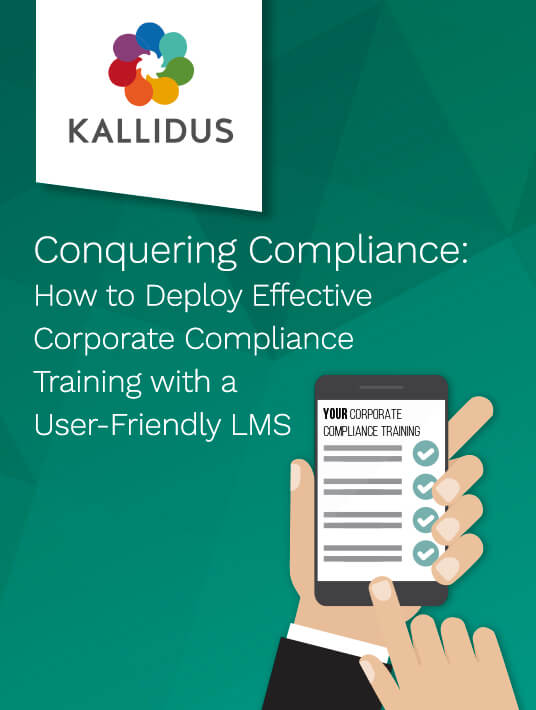Corporate Compliance Training: How To Choose An LMS To Fit Your Needs
Firstly, you need to assess why your current learning strategy isn’t working. Is a paper-based system too cumbersome? Is your current system failing to meet reporting or data-led expectations? Has your organisation expanded beyond the capabilities of your current learning plan? Whatever reason you have for shopping around for a new LMS, you should always search for the criteria that meet your organisation’s needs.

When it comes to compliance training, there are many needs an LMS should fulfil, so here are a few to look out for and questions to ask.
1. Is The LMS Adaptable For Growth And Change?
Whether your organisation has 50 employees or 10,000, it is vital to invest in an LMS that is scalable and adaptable for growth. One of the best benefits of moving your compliance training online is this adaptability, but without an LMS that can expand as your organisation does, your strategy may get left behind. Instead, discuss the platform’s growth opportunities with your contacts at the LMS provider to understand the system’s capacity.
2. How Useable Is The Admin-Side Of The LMS?
This is a vital consideration for any technological investment your organisation may undertake. The success of compliance training, however, is so heavily based on data and analytics that it is incredibly important that your admin, HR, L&D, and management teams can access everything they need about your employees’ development quickly and easily. Your LMS provider should have spent as much time developing a functional backend as they have developing the usability of the front.
3. Who, On Your Side, Is Taking Ownership Of The LMS?
When we say ownership, we don’t just mean the investment decision. Once the LMS is implemented in your organisation, who on your side is going to be investing their time and resources on the upkeep, functionality, learning pathways, and reporting? This will likely encompass a wide variety of employees, from HR to IT departments, but when investing in an LMS, it’s important to consider the needs of everyone involved in the upkeep of the product as well as the learners who will be completing their compliance training on it.
4. Does The LMS Allow For Both On And Offline Learning?
Compliance training takes many forms, and it’s important that your new LMS can live up to those needs. For example, some compliance training may require in-person competency and skills checks as well as an online quiz or exam after consuming eLearning content. An adaptable LMS will enable you to integrate the results of the in-person and classroom-based learning with the results and data from technology or device-driven training.
5. Is The LMS Intuitive For Learners?
Usability of your LMS plays a huge part in compliance training completion rates as well as wider aspects of your learning strategy. Employees are more likely to use your LMS on a regular basis if the system is intuitive and familiar. An easy-to-use LMS, for example, follows the lead of websites and applications such as Facebook and Netflix to guide its users through their learning experiences. This reduces the time learners need to invest to find their courses. This may not only maximise productivity outside of the realm of training but it can also encourage and empower learners to take more responsibility for their learning.
6. What Does The LMS Allow You To Report On?
Assessing the success of your compliance training doesn’t just come down to completion rates. Other elements worth looking at include dates of completion if your learners went on to complete any other courses (including non-compulsory), and, depending on your compliance training KPIs as an organisation, breakdowns of these across employee level (e.g. assistant, exec, manager, etc.).
What you need to report on and how often you need to do so will vary from organisation to organisation, but extensive compliance reporting is a great way to assess the effectiveness of your courses, how engaged your learners are if your courses are impacting KPIs, and how effective your strategy is overall.
7. How Smooth Is The Implementation Process?
A great product is one thing, but integrating it into your current working lives is another completely. The implementation of your new LMS should be as painless as possible. Ideally, you want to be working in tandem with the organisation providing you with this technology – it shouldn’t be down to just you or just your supplier to drive your LMS from investment to implementation.
Your new provider’s attitude towards implementation should reveal a lot about the ongoing relationship you are about to invest in. After all, with ongoing technological needs and updates, it is likely that ongoing support and communication will be needed.
8. How Simple Is It To Direct Different Learners Towards Different Courses?
While some compliance training will need to be undertaken by everyone in your organisation, others will be specific to the types of the job each employee is doing. For example, boiler engineers regularly working in the field will require completely different compliance training to someone working in your organisation’s finance department.
One of the most important considerations to make, and one that is often overlooked, is: how automated can the process of personalised learning pathways be? Your need for this will differ depending on the size of your organisation, but it is definitely worth considering this as a part of scalability and future compliance training.
Investing in a new LMS, whether you’re moving from an old one or taking a step forward into technology-based training, is a vital decision for your organisations ongoing L&D strategy. It pays to do your research, and using these 8 questions, we hope you will find it easier to choose the LMS that is right for your corporate compliance training.









